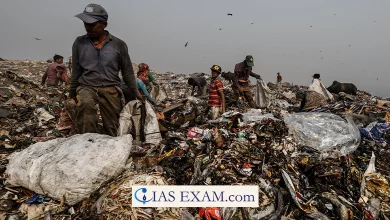Daily Current Affairs for UPSC
Majority of cities far from clean air target
Syllabus: Environment and Pollution[GS Paper-3]

Context:
- The National Clean Air Programme in India had a goal of reducing particulate matter concentrations by 40% in 131 cities by 2026.
- However, a study revealed that only four out of 49 cities with consistent data achieved or exceeded the desired decline in PM 2.5 levels over a five-year period.
Details about the report:
- Major cities of India such as Delhi and Mumbai have witnessed slight reductions or even inclines in pollution.
- However, cities such as Varanasi, Agra and Jodhpur have significant decrease in PM 2.5
- These are commendable improvements, but concerns persist because the major part of most polluted cities is located in Indo-Gangetic Plain where Delhi and other northern eastern civics face winter peak pollution.
- Only two cities outside of this region, Guwahati and Rourkela, featured in the list of top 20 most polluted cities for PM
- The number of air quality monitors differs significantly between cities, and only a few have enough to make the measurement accurate.
- The geographical locations, emission sources and meteorological influences should be studied so as to better understand the effect of these variables on pollution levels.
- Things have changed in the aspect of pollution but challenges are not yet fully overcome.
- The National Clean Air Program (NCAP) has set aggressive standards for air quality, and increasing the number of air quality monitoring stations are likely to help grant a clearer perspective on the issue.
NCAP:
- The National Clean Air Programme (NCAP) was launched by the Ministry of Environment, Forest and Climate Change (MoEFCC) in January 2019.
- It aims to address air pollution comprehensively across the country and achieve a 20-30% reduction in particulate matter concentrations by 2024.
- The program identifies non-attainment cities that do not meet the national air quality standards and prepares city-specific action plans to reduce pollution.
- The implementation of these plans is monitored by committees at the central and state levels.
- The program also focuses on coordination between different ministries, governments, and agencies, and incorporates existing policies and programs related to climate change.
- It emphasizes the need for increased monitoring stations, awareness, and capacity-building initiatives, and the establishment of certification agencies for monitoring equipment and source apportionment studies.
- The NCAP tracker is a collaboration between the Carbon Copy portal and Respirer Living Sciences.
Purpose of NCAP:
- The goal is to improve and expand air quality monitoring networks nationwide.
- There should also be effective ways to share data and educate the public on preventing and reducing air pollution.
- Additionally, there should be a practical plan to manage and reduce air pollution.
Way forward:
- Although progress has been made in tackling air pollution, certain cities are still facing higher levels of pollution.
- The updated target of reducing particulate matter by 40% by 2026 shows a strong dedication to environmental goals.
- The analysis highlights the importance of continuous efforts, improved monitoring, and comprehensive strategies in order to achieve the objectives of the NCAP and improve air quality in Indian cities.
Source: The Hindu





.png)



